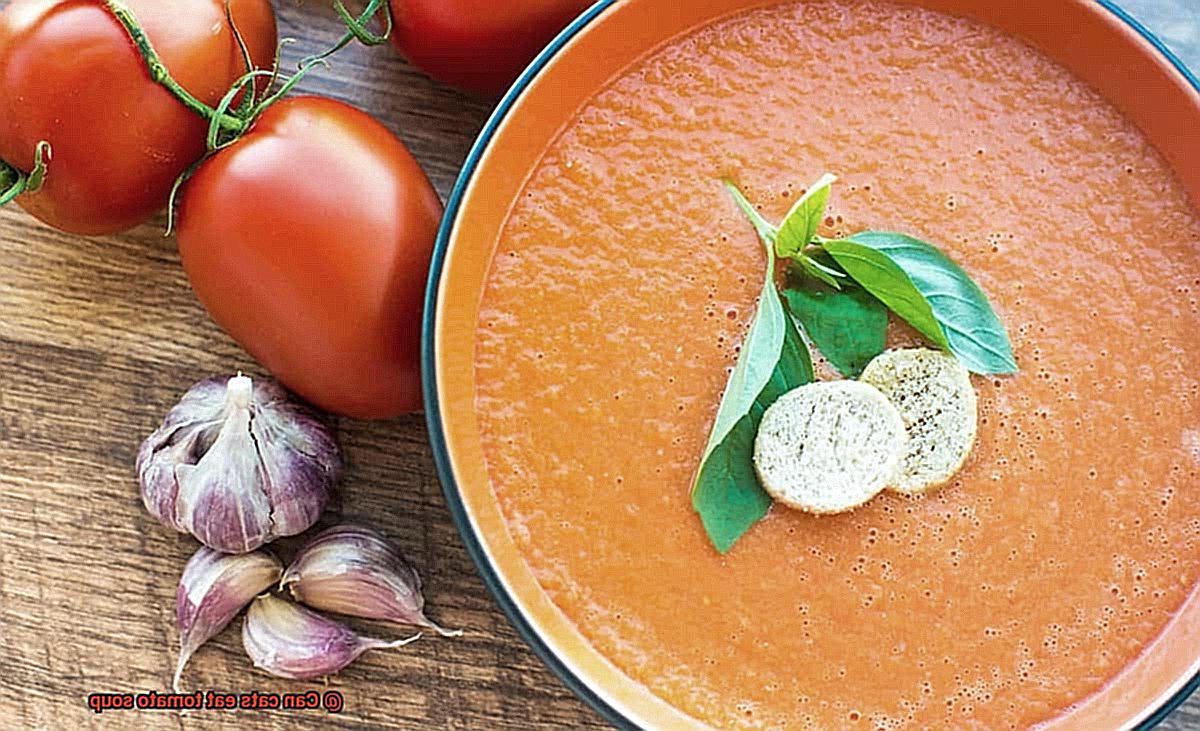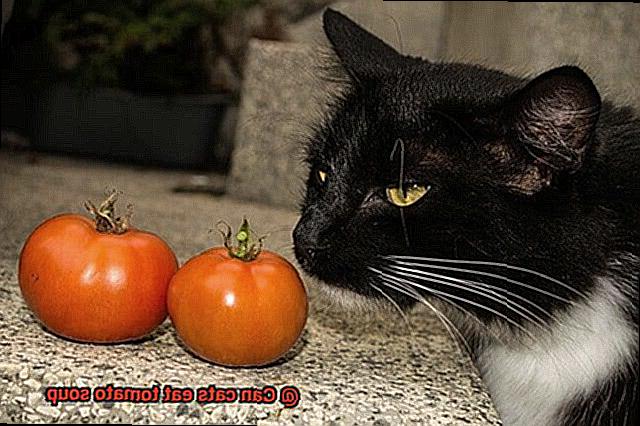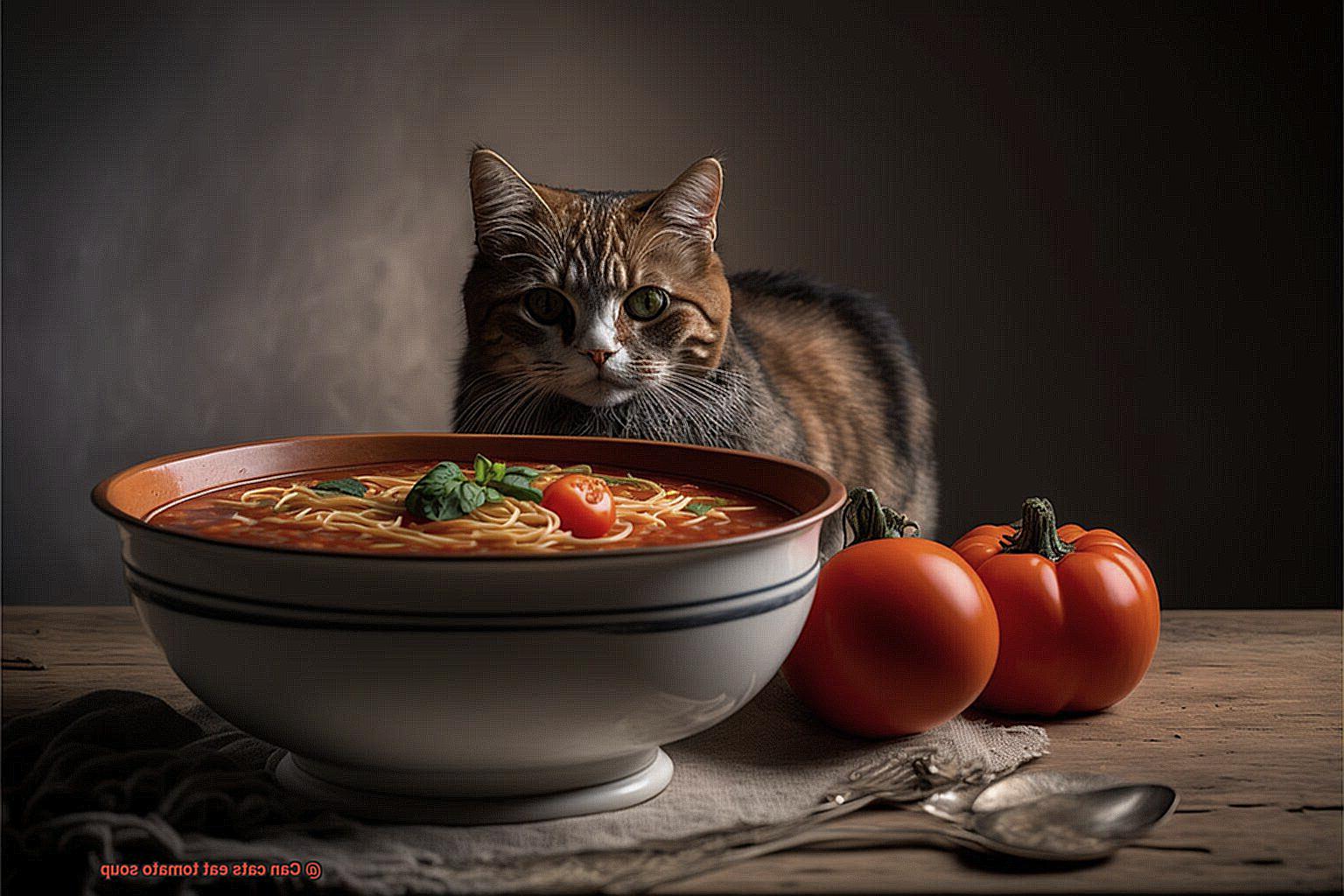Hey there, fellow cat enthusiasts and curious minds. Do you ever find yourself snuggled up with a steaming bowl of tomato soup on a chilly evening, wondering if your feline friend would enjoy it too? Well, wonder no more. The answer is yes, but with some important caveats.
As obligate carnivores, cats require a diet rich in meat-based protein to thrive. While they may occasionally snack on fruits and veggies, these won’t provide the essential nutrients they need. Tomato soup should not be a regular part of their diet due to its high sodium content and potentially toxic ingredients like garlic and onions.
But fear not. In this blog post, we’ll explore the ins and outs of cats and tomato soup. We’ll weigh the potential benefits against the risks of feeding this cozy treat to your kitty. Plus, we’ll share tips for safely incorporating small amounts of tomato soup into their diet and suggest alternative ways to offer them a warm, hearty treat they can enjoy guilt-free.
So grab a spoon (or paw) and get ready for an informative read about our feline friends and their relationship with tomato soup.
Nutritional Benefits of Tomato Soup for Cats
You may be wondering if tomato soup is a healthy choice for your feline companion. While there are some nutritional benefits of tomato soup for cats, it is important to consider both the pros and cons before adding it to their diet.
On the positive side, tomatoes are a fantastic source of vitamins A and C, potassium, and fiber, which can promote your cat’s immune system, vision, and digestive health. Tomato soup is also an excellent way to increase your cat’s hydration levels, which is crucial for their kidney function and overall well-being.
However, not all tomato soups are created equal. Many commercial varieties contain high amounts of sodium and other additives that can be harmful to your cat’s health. Sodium can lead to dehydration and kidney problems in cats while onion or garlic powder can damage their red blood cells. Therefore, it is best to avoid giving your cat canned or store-bought tomato soup.
If you choose to give your cat tomato soup, it is recommended that you make it yourself using fresh ingredients and low-sodium broth. This will help ensure that your feline friend gets all the nutritional benefits of the tomatoes without any harmful additives.

It is also essential to monitor your cat’s reaction when introducing tomato soup into their diet. Some cats may be allergic or sensitive to tomatoes, and they may experience vomiting, diarrhea, or other symptoms after consuming the soup.
While tomato soup can be a part of your cat’s diet in moderation, it should not replace their regular high-protein diet. As obligate carnivores, cats require meat-based diets that provide essential amino acids like taurine for heart and eye health. Therefore, it is crucial to consult with your veterinarian before making any significant changes to your cat’s diet.
Risks of Feeding Tomato Soup to Cats
When it comes to tomato soup, it’s important to think twice before offering it to your beloved pet. While this comfort food may be a popular choice for humans, it can pose several risks to cats that every pet owner should be aware of.
Firstly, the high sodium content in most canned tomato soups can be detrimental to your cat’s health. Excessive salt intake can lead to dehydration, kidney problems, and even high blood pressure, which can be particularly dangerous for cats with pre-existing health conditions.
Furthermore, some tomato soups contain harmful ingredients such as garlic and onion powder, which can cause anemia and gastrointestinal distress. These symptoms can be life-threatening if left untreated and may require immediate veterinary attention.
Even if the soup doesn’t contain these harmful ingredients, the acidic nature of tomatoes can cause stomach upset in some cats. This can result in vomiting or diarrhea, which is not only unpleasant for your cat but also messy for you to clean up.
Lastly, feeding tomato soup to cats regularly can lead to weight gain and obesity. This comfort food is high in calories and can quickly add up if included in your cat’s diet regularly. Obesity in cats increases the risk of several health problems, including diabetes, heart disease, and joint problems.
What Ingredients Should Be Avoided When Feeding Tomato Soup to Cats?
While tomatoes are generally safe for cats to eat, it’s important to be mindful of the ingredients that are included in the soup. As an expert on the topic, I’m here to break down what ingredients should be avoided when feeding tomato soup to your beloved kitty.

Firstly, onions and garlic are a major concern. Even small amounts of cooked onions or garlic powder can cause anemia and other health issues in cats. So, before serving up tomato soup to your fluffy friend, make sure there’s no onion powder lurking in the ingredient list.
Next on the list is salt, which can lead to dehydration and other health problems if consumed in excess. Many tomato soups contain high levels of sodium, so it’s important to check the label and ensure it’s within a safe range for your fur baby.
Dairy products like cream or milk are also a common ingredient in tomato soup. However, many cats are lactose intolerant and cannot digest dairy properly. It’s best to avoid these ingredients altogether to prevent any digestive upset and discomfort for your furry companion.
Spices such as pepper or paprika may add some flavor to tomato soup for humans, but they can cause digestive upset in some cats. While these spices may not be harmful in small amounts, it’s better to err on the side of caution and skip them altogether.
How to Make a Healthy Tomato Soup for Your Cat
While cats are obligate carnivores, it’s natural to want to treat them with something special every once in a while. If you’re considering making tomato soup for your cat, there are a few things you should keep in mind to ensure that it is healthy and safe for them to consume.
Choose Fresh Tomatoes

Using fresh tomatoes is crucial when making tomato soup for your cat. Canned tomatoes often contain added salt and preservatives that are not ideal for feline consumption. Additionally, it’s important to remove the skin and seeds from the tomatoes before cooking as they can be difficult for cats to digest.
Add Vegetables for Extra Nutrition
If you want to add some extra nutrition to your cat’s tomato soup, consider adding in some cooked vegetables such as carrots or sweet potatoes. These veggies are high in fiber and vitamins that can provide a boost of nutrition for your furry friend.
Keep it Simple

When it comes to seasoning the soup, simplicity is key. Avoid using any salt or spices as these can be harmful to cats. Instead, consider adding in some fresh herbs such as parsley or basil for flavor.
Beware of Harmful Ingredients

Many store-bought tomato soups contain ingredients that may be harmful to cats, such as garlic and onion powder, which can cause digestive issues and even lead to anemia. Always read the labels carefully before purchasing any tomato soup for your cat.
Consult with Your Veterinarian
It’s always a good idea to consult with your veterinarian before introducing any new foods into your cat’s diet. They can advise you on whether or not tomato soup is a healthy choice for your particular cat.
Alternative Foods You Can Feed Your Cat Instead of Tomato Soup
One such example is tomato soup. Tomatoes contain an alkaloid called solanine, which can be toxic to cats in large quantities. This can cause digestive issues, lethargy, and even seizures in severe cases. So, if you’re looking for alternative foods to feed your cat instead of tomato soup, we’ve got you covered.
Cooked Chicken or Turkey

One of the best alternatives to tomato soup is cooked chicken or turkey. These protein-rich meats are easy for cats to digest and provide essential nutrients like amino acids and vitamin B1But make sure to remove any bones before serving as they can be a choking hazard.
Cooked Fish
Another tasty option is cooked fish such as salmon or tuna. These fish are high in omega-3 fatty acids that promote healthy skin and coat in cats. However, it’s important to avoid feeding your cat raw fish as it may contain harmful bacteria that can cause digestive issues.
Cooked Vegetables
If you’re looking for a healthy snack option, try feeding your cat some cooked vegetables such as carrots or green beans. These veggies are low in calories and provide important vitamins and minerals like vitamin A and fiber. Chop them up into small pieces so your cat can easily chew and digest them.
High-Quality Cat Food

Another convenient and healthy option is high-quality cat food available on the market. Look for brands that use real meat as the primary ingredient and avoid those that contain fillers like corn or wheat. This ensures that your cat is getting a balanced diet with all the necessary nutrients.
Tips on Introducing New Foods to Your Cat
Introducing new foods to your cat can be a delicate process, especially if your furry friend is a picky eater or has a sensitive stomach. However, there are some tips and precautions you can take to make the process smoother and safer for your feline companion. Here are five sub-sections that will guide you through the process step-by-step.
Introduce New Foods Gradually:
Your cat’s digestive system needs time to adjust to new foods. Introduce a small amount of the new food and slowly increase the portion size over time. Gradual introduction reduces the risk of gastrointestinal distress and allows your cat to get used to the taste, texture, and smell of the new food.
Check Ingredients List:
Ensure that the new food is appropriate for your cat’s dietary needs. Cats are obligate carnivores, which means they require a diet high in protein and low in carbohydrates. Check the ingredients list before introducing any new food to make sure it meets your cat’s dietary needs. Avoid foods that contain harmful additives or ingredients that could be toxic to your cat.
Test for Allergic Reactions:
Before offering a new food to your cat, introduce small amounts of it as a treat to see if there are any adverse reactions, such as an upset stomach or vomiting. If your cat shows signs of an allergic reaction, including skin rash or difficulty breathing, stop giving them that food immediately.
Consult with Your Veterinarian:
Your veterinarian can advise you on whether the new food is appropriate for your cat’s individual needs and can provide guidance on portion sizes and feeding schedules. They can also recommend specialized diets for cats with specific health conditions.
Observe Your Cat’s Behavior and Appetite:
It’s essential to monitor your cat’s behavior and appetite after introducing new foods. If your cat shows signs of an upset stomach or vomiting, it’s best to avoid giving them that food altogether. If your cat enjoys the new food, gradually include it in their diet.
Does My Cat Need Special Supplements If I Feed Them Tomato Soup?
The answer is that while tomato soup can be given as an occasional treat, it’s not a complete and balanced meal for your cat. Therefore, it’s crucial to make sure they’re still getting all the necessary nutrients they need to maintain good health.
Tomatoes contain solanine, which can be toxic to cats in large amounts. However, the amount of solanine in tomato soup is generally considered safe for cats. Still, it’s important to note that tomato soup should only be given as an occasional treat and not as a regular part of their diet.
So, if you’re planning to give your cat tomato soup, what else should you keep in mind? The answer lies in providing your cat with a high-quality, nutritionally complete cat food that meets all their dietary needs, including essential vitamins and minerals. This will ensure that they’re not missing out on any vital nutrients that they need to stay healthy.
Moreover, it’s always advisable to consult with your veterinarian before making any significant changes to your cat’s diet or introducing new foods or supplements. Your vet may recommend additional supplements or dietary changes based on your cat’s individual needs.
2KZAW2alLM0″ >
Conclusion
To sum up, while it’s technically possible for cats to eat tomato soup, it’s not recommended as a regular part of their diet. Although there are some nutritional benefits to be had from the occasional serving of tomato soup, such as improved immune system function and hydration levels, cat owners should be aware of the potential risks involved.
The high sodium content in many canned or store-bought tomato soups can lead to dehydration and kidney problems in cats. Additionally, harmful ingredients like garlic and onions can cause anemia, gastrointestinal distress, weight gain, and obesity. It’s therefore best to avoid these types of soups altogether.
Instead, consider making your own low-sodium tomato soup using fresh ingredients or offering alternative foods like cooked chicken or turkey, cooked fish, cooked vegetables, or high-quality cat food. When introducing new foods into your cat’s diet, always do so gradually and keep an eye out for any adverse reactions.
If you’re unsure whether a particular food is safe for your cat to eat or how much they should be eating of it, consult with your veterinarian before making any significant dietary changes.







